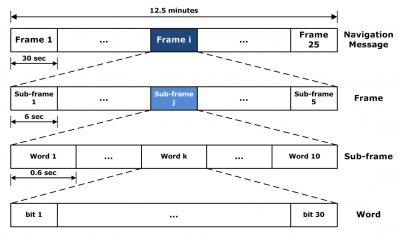If you wish to contribute or participate in the discussions about articles you are invited to contact the Editor
GPS Navigation Message
| Fundamentals | |
|---|---|
| Title | GPS Navigation Message |
| Author(s) | J. Sanz Subirana, JM. Juan Zornoza and M. Hernandez-Pajares, University of Catalunia, Spain. |
| Level | Basic |
| Year of Publication | 2011 |
Every satellite receives from the ground antennas the navigation data which is sent back to the users through the navigation message. The Navigation Message provides all the necessary information to allow the user to perform the positioning service. It includes the Ephemeris parameters, needed to compute the satellite coordinates with enough accuracy, the Time parameters and Clock Corrections, to compute satellite clock offsets and time conversions, the Service Parameters with satellite health information (used to identify the navigation data set), Ionospheric parameters model needed for single frequency receivers, and the Almanacs, allowing the computation of the position of ”all satellites in the constellation”, with a reduced accuracy (1 − 2 km of 1-sigma error), which is needed for the acquisition of the signal by the receiver. The ephemeris and clocks parameters are usually updated every two hours, while the almanac is updated at least every six days. The current “legacy” Navigation Message (NAV) is modulated on both carriers at 50 bps. The whole message contains 25 pages (or ’frames’) of 30 seconds each, forming the master frame that takes 12,5 minutes to be transmitted. Every frame is subdivided into 5 sub-frames of 6 seconds each; in turn, every sub-frame consists of 10 words, with 30 bits per word (see figure 3). Every sub-frame always starts with the telemetry word (TLM), which is necessary for synchronism. Next, the transference word (HOW) appears. This word provides time information (seconds of the GPS week), allowing the receiver to acquire the week-long P(Y)-code segment.
The content of every sub-frame is as follows:
- Sub-frame 1: contains information about the parameters to be applied to satellite clock status for its correction. These values are polynomial coefficients that allow converting time on board to GPS time. It also has information about satellite health condition.
- Sub-frames 2 and 3: these sub-frames contain satellite ephemeris.
- Sub-frame 4: provides ionospheric model parameters (in order to adjust for ionospheric refraction), UTC information (Universal Coordinate Time), part of the almanac, and indications whether the Anti-Spoofing, A/S, is activated or not (which transforms P code into the encrypted Y code).
- Sub-frame 5: contains data from the almanac and the constellation status. It allows to quickly identify the satellite from which the signal comes. A total of 25 frames are needed to complete the almanac.
Sub-frames 1, 2 and 3 are transmitted with each frame (i.e., they are repeated every 30 seconds). Sub-frames 4 and 5 contain different pages (25 pages each) of the navigation message (see figure 3). Thence, the transmission of the full navigation message takes 25 × 30 seconds = 12.5 minutes. The content of sub-frames 4 and 5 is common for all satellites. Thence, the almanac data for all in orbit satellites can be obtained from a single tracked satellite. GPS modernisation introduces four new data messages: CNAV, CNAV-2, L5-CNAV and MNAV. The first three are civil messages, while the MNAV is a military message. They provide more accurate and frequent message data than the legacy navigation message (NAV).
CNAV and MNAV have a similar structure and modernised data format. The new format allows more flexibility, better control and improved content. Its design replaces the use of frames and sub-frames of data (repeating in a fixed pattern) of the original “legacy” NAV by a packetised message-based communications protocol, where individual messages can be broadcast in a flexible order with variable repeat cycles. Moreover, Forward Error Correction (FEC) and advanced error detection (such as a CRC) are used to achieve better error rates and reduced data collection times. Furthermore, the MNAV includes new improvements for the security and robustness of this military message. A preliminary description of the CNAV structure can be found in the Interface Specification (IS)-GPS-200D [GPS Joint Program Office, 2004]. It includes up to 63 different message types, of which 15 types have already been defined. The L5-CNAV is modulated onto L5I signal component, containing basically the same information data as NAV and CNAV, but in a different format. The CNAV-2 provides more accurate data, it is modulated onto L1CD, and it is divided into frames, which are sub-divided into three subframes.
References
- DoD, USA, 1995 Global Positioning System Standard Positioning Service Performance Standard.
- DoD, USA, 2007 Global Positioning System Precise Positioning Service Performance Standard.
- DoD, USA, 2008 Global Positioning System Standard Positioning Service Performance Standard.
- GPS Joint Program Office, 2004 Navstar GPS Space Segment / Navigation User Interfaces (IS-GPS-200D).
- Mc Donald, K. and Hegarty, C., 2000. Modernization GPS Performance Capabilities. In: Proceedings of ION 56th Annual Meeting, 25-26 June 2000, San Diego California USA, pp. 242-249.

